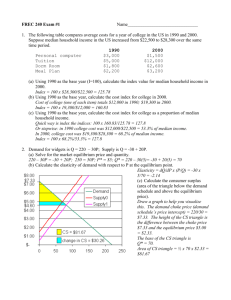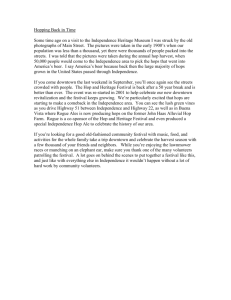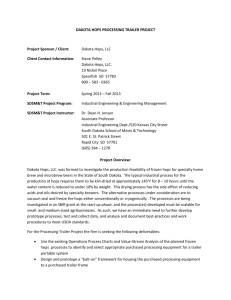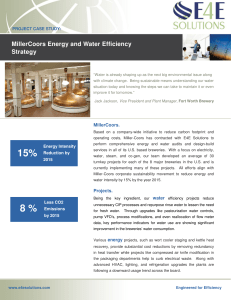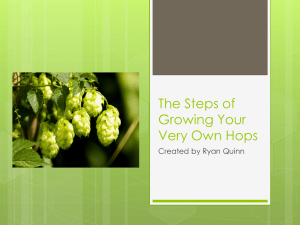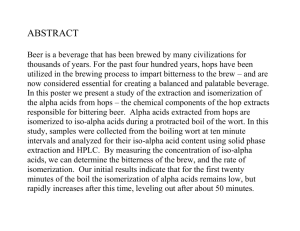Beer Research & Insights
advertisement
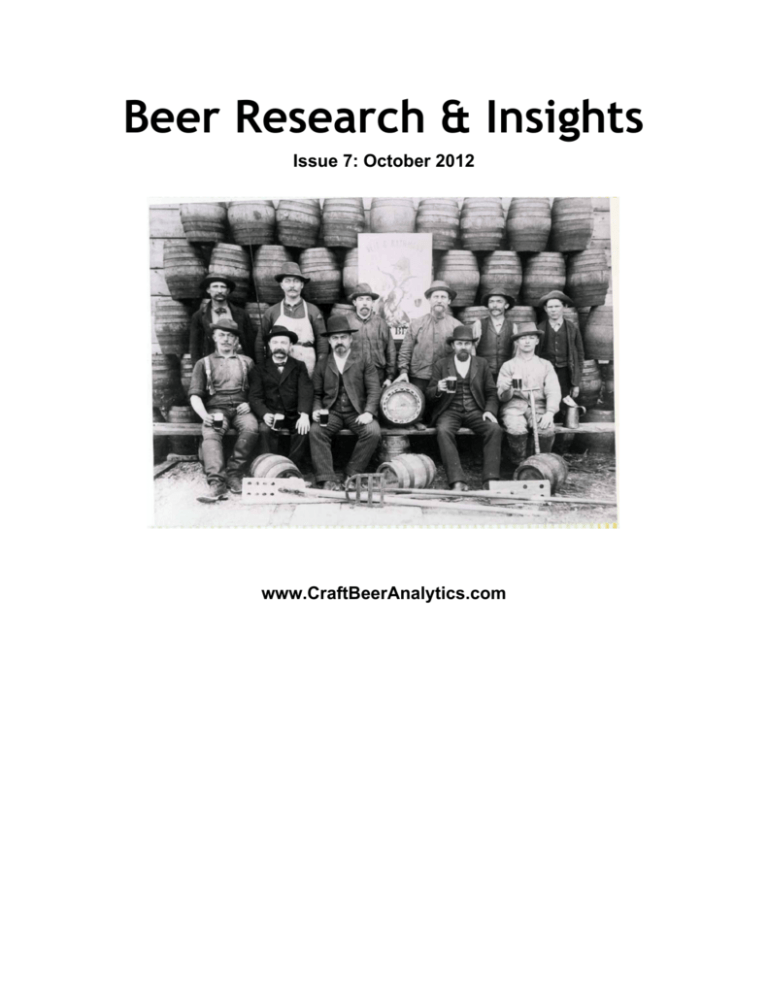
Beer Research & Insights Issue 7: October 2012 www.CraftBeerAnalytics.com Welcome to our seventh issue of Beer Research and Insights. This monthly newsletter provides breweries with research insights and has the same mission as we do at Craft Beer Analytics, to help craft breweries become more efficient, more prepared, and better equipped to continue nonconformity. In this issue you will find a beer commodity analysis, forecasts of where commodities are headed, as well as providing powerful research insights. The goal of this newsletter is to be helpful and show our focus keeps yours on beer. Any feedback can be directed to us at craftbeeranalytics@gmail.com or on Twitter: @Beer_Data. Cheers, Craft Beer Analytics Table of Contents Commodity Analysis ○ Wheat ○ Barley ○ Malt ○ Hops ● Policy Study: The Rise of the Brewery ● Charts of the Month ● Before You Go ● Commodity Analysis This section is a commodity analysis of wheat, barley, malt and hops. Our focus is to provide some insights on where these commodity prices are going. We mainly focus on prices, however, with hops we will focus on production, as hops are not traded on any public market. However, knowing the supply and demand of hops now and into the future can provide a lot of information regarding future hops prices. For our forecasting, we use two types of forecasting methods. The first being a basic trend forecast from the most recent data point and the second being a slightly more sophisticated ARIMA forecast, which takes underlying characteristics from data and projects them forward. There are even more sophisticated methods that require more data and information, but our goal is to get an idea of where prices are headed. Both types of forecasts take patterns from the past data and projects the patterns into the future. Please note that these forecasts should be used for estimates of future price movements and these forecasts assume that current conditions do not change dramatically. The best way to stay up to date on where prices are headed is by reading each month’s Beer Research & Insights. Wheat Looking at wheat prices over the last 5 years, we notice two major run ups in prices. We are currently off recent highs in late 2010 and early 2011. We have had some falling wheat prices earlier this that have actually started to make a significant impact, but we have finally seen those decreases erased by price increases due to worldwide droughts in areas of heavy wheat production. Our simplistic trend forecast is shows that October is above the long run average for wheat prices. Our trend suggests a correction is needed followed by slow growth. Our more sophisticated ARIMA model tells us to expect wheat prices to hover around the $340’s per metric ton before falling in early 2013. The most telling part of these forecasts is that wheat is above its historical trend but this recent increase in price has some legs, expect wheat to be in this price range for the near future. Barley Looking at barley prices over the past 5 years, we notice the summer of 2008’s price boom, which was followed by a bust in barley prices. However prices have gradually increased. We recently seen barley’s price increase to levels that haven’t been seen since early 2011. Our long term trend forecasts shows that we are above the historical trend, but the forecast is showing strong growth. This means according to the longer term trend line, barley may be slightly overpriced but it agrees that there will continue to be long term increases in barley prices. Our more sophisticated ARIMA model is suggesting falling barley prices in the future, this model is based on past characteristics in barley data, but we put a little more faith in falling prices but do would be surprised if short term increases in prices remain. Malt Our malt usage by U.S breweries will see falling malt usage in the long term and in the next few months. Malt usage by U.S breweries is fairly easy to anticipate. Hops This month we have not done as much with hops as we usually do, mainly because we do not want to overly regurgitate annual data every month. This month we’ve included a correlations chart between hops varieties to give you a better idea of the relationship between different types of hops. In this issue we utilize hops data from the Barth Hops Report. This month we will break out our hops section by varieties and will not use the U.S government data when evaluating hops, any differences is due to data sources. Since the Barth Hops Report is only an annual report, we decided to only look at U.S hops hectares of hops grown. In future issues we will dig deeper into past data and actual production and alpha numbers. Our goal is to start this issue by seeing where certain varieties of hops are headed based on how many hectares are used in growing those particular hops. Our main assumption is the more hectares used for growing hops the larger the production of hops will be. Since we are only looking at a few of the varieties and not all, we did provide a chart that shows hectares data for the majority of the varieties. Also, we use 0 when the data was not available or not reported, this does not mean there was necessarily no production of that particular hops variety in that given time period. This month, in addition to our normal hops forecasts, we dig a little deeper using GARCH models. GARCH models essentially allow us to identify the volatility of the particular species of hops and can be used in forecasting hops. Knowing the volatility and variance can lead to better forecasts. Since we are looking at risk in this issue, we will first look at the volatility of a few particular varieties of hops to get a better understanding of the potential risks. We are using the amount of hectares used for the production of hops in the U.S as a proxy for the actual production numbers, i.e we are assuming the more land used for production the more production there will be. Acres used for developing hops in the United States in 2011 fell. However a long term trend of 17 years (although anything beyond 5 years will tell the same story) shows that our long term trend will be more acres used for developing hops. Our basic long term trend line not only tells us that we should expect more hops in the future but at this point we may be below our long run trend. The same story holds for our exponential trend, just expect more greater production increases than our basic long term trend line. High alpha hops in America also show a similar story of a recent fall in acres used but an increasing long term trend line (red). We also see that acres used for high alpha hops is slightly below the long run trend but it’s very close. We did see a correction after 2009 but continue to expect more high alpha hops production in the U.S in the future. Our GARCH model forecast, in yellow, for total supply of U.S high alpha hops tells us to expect flat growth in high alpha production. A possible shock to high alpha hops would result be very persistent and have a long lasting impact. In general high alpha hops when impacted from outside forces will be positively impacted from a shock by outside forces but it is not persistent. When we speak of outside forces or exogenous forces, we mean an unpredictable or unexpected event from outside the standard economics of beer and in these cases hops. Exogenous shocks could be weather storms, a financial crisis, terrorist attacks among many other unpredictable events. The Cascade hops variety has seen some very strong growth in acres used in development over the past 17 years. We actually see our current number of acres being used to very close to the long run trend. Again expect to see some manageable growth in Cascade hops by U.S hops farmers. Instead of using a GARCH model for Cascade hops, at least for forecasting (because of model mis-specification) we used a moving average forecast, which is yellow. The moving average forecast suggests falling usage in Cascade hops production, but we do not put a lot of credibility behind the forecast due to lack or historical data. Our GARCH model for Cascade hops tells us that a shock to Cascade hops will be very persistent and long lasting. In general, Cascade hops when impacted from outside forces will have longer lasting impacts and thus cause greater volatility from before and after a shock to the system happens, but the actual volatility from the response isn’t that great, it’s just lasts for a long period of time. Cascade generally has positive production response to an exogenous shock. Aroma hops within the U.S are seeing falling number of acres used for production. The 17 year trend line is showing a falling number of aroma hops from the U.S in the future and that we are producing below the long run trend line. This is likely from a lack of strong demand or just a long term correction in growing aromatic hops. Our GARCH forecast suggests of increasing total aroma hops production over time. We put a little more faith in our GARCH forecast. Our GARCH model tells us that the sum of the coefficients on the lagged squared error and lagged conditional variance for high aroma hops isn’t too close to one and this tells us that shocks to the total aroma hops supply isn’t persistent over time. This tells us that the total supply of aroma hops isn’t overly affected by exogenous shocks like weather, financials or other outside forces. Also supply of total aromas actually responds favorably to shocks and isn’t overly affected. In other words, the total supply of aroma hops does respond to outside shocks but they are not persistent, and is only moderately volatile. Our data source only had CTZ hops data from 2000 and on. We see that there has been strong growth in CTZ hops over the past 11 years but we did see recent drops in acres used for growing this variety. At this point we continue to expect CTZ hops cultivation to increase in the future after the recent fall. Our GARCH forecasts suggest the same growth in CTZ but at an even higher rate. The GARCH model does take volatility into consideration and thus is likely to be more accurate of a forecast. We are currently around 1,000 hectares from our long run trend line. According to our GARCH model Columbus-Tomahawk-Zeus supply does have some strong volatility after being impacted by an exogenous shock, but the impact is not persistent or long lasting, and CTZ has a positive production response to any significant shocks. Centennial hops have also seen some strong growth over the past six years. Currently Centennial hops are above their long term trend line and their exponential trend for hectares used in production. However we expect the long term trends to continue for some time, but slightly less so than in the past few years. Acres used for producing Willamette hops have also been shrinking and has seen some recent acceleration by hops farmers towards moving away from Willamette. There had been a steady numbers until 2008, in which acres used for Willamette shrunk very fast. We are currently well below the long-run trend line and this is likely a sign of falling demand and substitution towards other hops. Instead of doing a GARCH forecast for Willamette hops, we used a moving average model instead due to model mis-specification, which is in yellow. Both the trend (red) and moving average (yellow) forecasts suggest higher production in the short-run but in the long-term Willamette is likely to see falling production. These models rely heavily on past characteristics of Willamette hops, so we would not be surprised if the numbers continued to decline, but given how Willamette hops have performed in the past such a swift fall in Willamette hops production would be unusual. For Willamette hops, our Garch model suggests that exogenous shocks do not lead to persistent or long last impacts on Willamette hops. In other words, Willamette hops production is fairly robust from outside forces and is thus impacted more from demand than forces outside of a producer's control. Our hops forecasts do provide some insight on future strategies for breweries. If we are seeing falling hops hectares being cultivated for a particular hops variety, it may be wise to secure future contracts with farms or start thing of possible substitutable varieties. Farmers tend to favor hops the provide the most yield and business. Hops that are not being focused on are either too costly to produce, not providing enough yield (economically or through farming) or that demand just isn’t there. Growing the right hops is a big deal and keeping a pulse on what hops are being cultivated and which ones are not is a good indicator of future supply and prices. Hops correlations: This month we provided a chart of correlations among different varieties of hops. A correlation is simply showing the relationship among two variables. A positive correlation of one means two variables always move in the same direction together, a negative one for a correlation value means two variables are perfectly opposites of another. For instance a correlation of .80 means two variables move in the same direction 80% of the time. We won't make too many conclusions on these correlation values but they can be interesting from a planning perspective. Again we are looking at U.S hectares used for hops production for each variety of hops and assuming the more hectares used the more production there will be. Some hops have high correlations with one another because those are both in demand, or high negative correlations can show one is in demand and the other has fallen out of favor or maybe the two are competitors. Really this is included to allow readers to make some of their own conclusions. We also would like to remind you all that some varieties do not many years of data and some correlations can be mere coincidence, the players that have been around for longer will have more accurate correlation values. Policy Study The Rise of the Brewery There has been a lot of recent interest in why there are so many breweries today than there has been in the past. The obvious answer is that there is a greater interest in craft beer and small scale beer operations that are now more likely to be profitable. However, craft breweries are not as easy to turn a profit as many believe. I think the most recent stat is about half the new breweries opening this year will be closed within three years. Whether this is true or not, a 50% survival rate for three years isn't that great, especially considering the capital expenditures around breweries. We decided to use a basic model to explain why there has been a large increase in craft breweries. We excluded the prohibition years as that era is dramatic and could impact our results. Prohibition is a beast of its own and was impossible to predict and likely to never happen again. We looked beyond using just demand as the answer to why there has been such an increase in the number of breweries and instead focused on the Cranston Act, Federal taxes on beer, the internet, U.S population and U.S GDP as our explanatory variables to the number of breweries in the United States. The Cranston Act is occurred in 1979 and allowed home breweries to sell on a small scale level. We expect this form of deregulation should explain some of the increase in breweries in the United States. We included federal excise beer taxes as a proxy to see if taxes could or would limit the number of breweries. Taxes can cause potentially profitable ventures to not occur because the benefits of starting a brewery can shrink, or that taxes are too great of a burden for breweries to survive. We understand that state taxes play a much larger role as they can be dramatically different among states, but they are much more difficult to aggregate, so we preferred the Federal excise taxes. Federal excise taxes are also interesting as they can explain how a tax difference can affect the number of breweries. We used the internet as a variable as it can explain a greater knowledge of craft beer and the possible differentiation that craft beer offers. We assumed the internet started in 1994, while that is not true, it was around the period of time when normal U.S consumers essentially started using it, and of course it exploded more in the 2000's. We included population to see if the growing or shrinking populations have an impact on the number of breweries and finally we used GDP as a way to see if overall U.S wealth played a factor. In one version of our model we did also look at GDP interacted with population growth instead of population and GDP. The results are very interesting but not too surprising. The Cranston Act, the internet, population and GDP were all significant factors in determining the number of breweries in the United States. The Cranston Act did increase the number of breweries. With this kind of model we are more interested in the statistical significance and the sign of a variable and less the precision of each variable. However if we were to believe the the Cranston Act variable's precision, it would explain some 249 breweries existence. However that number is dwarfed by the impact of the internet, the internet could be known to explain some 1700 breweries, we do not think this number to be exact, but it does suggest the internet increased the number of breweries and was 5-6 times more important than even the Cranston Act was. The internet has had such a huge influence because it informed the masses to types of beers and craft beers in general. It also lowered the costs to marketing for many breweries. Many residents of the Chicagoland and the suburbs of Milwaukee now drive for a few hours to New Glarus, Wisconsin for a weekend trip to try craft beers at the brewery. This would happen significantly less if there wasn't the internet to spread the word about New Glarus, let alone how to get there. A growing population will actually lead to less breweries, for every 100,000 gained in the U.S population we should expect 24 less breweries. This may seem baffling, but there is actually significant economic support for such results. Gregory Mankiw and a few other contributing authors wrote a paper in the 90's which found population growth actually hurt personal income and wealth within a country. Essentially, countries with high population growth rates tend to be poorer and have less money to spend on luxuries as craft beer. Once populations start slowing or even shrinking, individuals tend to be wealthier. The U.S' falling population growth rates are a good sign for breweries and not necessarily a bad thing. If we decide to include population and population squared to our model, there is a point where a growing population will encourage a growing number of breweries, but it would require a massive amount of population growth to force such demand increases by poorer citizens, and it would require population growth levels we've never seen. When we look at U.S GDP, we find that a growing economy does result in more breweries. This is fairly intuitive as the economy is stronger should result in more investing in breweries and more drinking premium beers. We found that GDP per capita is not significant in determining the number of breweries, we believe this is only true in our model as the influence of population and GDP essentially offset each other. So what does this mean to a craft brewery? Essentially craft breweries have grown quickly not only because of increased demand but also because of some key legislation and the internet. Taxes are not much of an issue because there hasn’t been much development in federal excise taxes and partly because other factors dwarf their impact. Craft breweries will want wealthier citizens and not necessarily major population growth. While there is not a lot that can be done at the micro level for a brewery based on this policy study, it is still worth understanding. Policy Review: This month we review "When Online Reviews Meet Hyperdifferentiation: A Study of the Craft Beer Industry" by Erik Clemens, Guodong Gao and Lorin Hitt. Essentially the paper is looking at beer rating sites, particularly ratebeer.com and testing the effectivenss of differentiating (specifically hyperdifferenctiation) and seeing if it leads to stronger sales growth. The authors believe that the more informed consumers become regarding a product, the more successful firms that use differentiation will become in the marketplace. The authors use sales data and online reviews and find that products with variance of ratings and strength of the most positive quartiles of reviews play a significant role in which products will grow the fastest. In layman's terms, craft beers with a wide range of reviews but a large amount of positive reviews (or consumers whom are huge fans) will have the highest growth despite the fact that many will also hate the product. It is better to be loved by few and hated than not being loved or hated at all. Don't be vanilla, at least according to Clemens, Gao and Hitt. The authors start by pointing out how a greater variety of products became popular with the rise of the 'information economy' and these products can range from books, movies, songs, and many other products. They believe that the internet is to craft beer what cable television (and prime channels) was for television shows, as it allowed people to branch out in their tastes. This is a concept I completely agree with. The authors are surprised that having a large variance (or spread) among reviews was as significant at predicting future sales, as much as the overall average rating for a craft beer. The authors also state that sales growth is very much related to the most enthusiastic group of consumers. This makes sense as the customers whom are committed to the craft beer, but will continually buy other beers from that craft brewery. These people as essentially the ambassadors to the product, brand and company. Essentially they are free advertising. Lululemon, a woman's yoga store, does not have any marketing, but their customers wear their products and sport the free high quality re-usable bags for all kinds of tasks (like grocery shopping at Whole Foods), essentially Lululemon’s fans push their growth. Other companies from Apple to Nike have the same approach, but with some marketing. The authors point out that at the time when the article was being published, Victory Brewing Company had never used more than 1.5% of sales for advertising campaigns, and that they had never used traditional paid media, but Victory Brewing has had consumer-generated demand or pull by 'beer geeks' using online beer review sites. The authors find a correlation between online reviews and sales, which is something we've pointed out in past issues. Essentially more reviews tends to lead to greater demand for a craft beer. Their overall findings are: premium products sell for premium prices, a greater dispersion of ratings is as important as the overall mean for a specific craft beer's rating. Having Higher ratings are a good predictor of future sales but having some poor ratings does not necessarily mean poor sales. The authors believe craft breweries should produce products that will have a wide range of ratings, even if it leads to as higher number of people hating the beer than if they produced an ordinary beer. Finally the authors find that a greater variance in ratings does correlate with higher sales and that high ratings are more important than poor ones. Craft beers need to memorable and different to have great sales in today's semi-informed beer market. We would like to say that we appreciate the simplicity of the models and feel that they provide accurate explanations of craft beer phenomena. Of course there are more predictive models, but the idea of this paper is not to predict but to inform and find answers, which these professors do accomplish. While improvements can be made, such as a larger sample size, we believe the overall conclusions are accurate. Charts of the Month This month we decided to look at 30 days (Mid September to Mid October) of beer advocate (beeradvocate.com) ratings for Lagunitas Rogue Ales, and Sierra Nevada. We were able to collect 250 observations and found some interesting insights. The most reviewed Lagunitas beer was Daytime followed by A Little Sumpin' Wild, and A Little Sumpin' Sumpin' Ale. Lagunitas' reviews were heavily concentrated towards a select few beers, Daytime had far more reviews than any other, Daytime had 43.35% of the reviews whereas A Little Sumpin' Wild which had the second most reviews only had 12.45% of all the reviews. Overall, Lagunitas had more favorable reviews than anything else. They had an average rating of 4.02 (A median of 4.08) out of 5 and had a maximum of 4.98. Similar to the results in the paper we reviewed this month, Lagunitas beers with higher standard deviations were statistically significant in having in higher beer ratings. For every 1% increase in standard deviation, led to a 0.89% increase in a beer's overall rating. For Lagunitas, it holds true that having craft beers with a wide range of ratings tended to be more favorable reviewed than a craft beer that has a smaller difference between the worst and best reviews. Most people are not overly excited about vanilla ice cream, but most people also don't hate it either. There is a strong point in this issue to not be vanilla. REDEV stands for standard deviation This month we also looked at Rogue's beer advocate reviews for 30 days. Compared to other breweries we looked at they were less concentrated on a select few beers. While Lagunitas had one beer with 45% of all the beer reviews, Rogue's most frequently reviewed beer over the 30 day period was Voodoo Doughnut Maple Bacon Ale, and it only accounted for 18.52% of all reviews, Dead Guy Ale had the second most number of reviews which were only 10 of the 135 observations we collected. Rogue is different from Lagunitas in not only on the lack of single concentration of reviews but how its reviews had greater densities towards higher reviews and very few negative reviews. While Rogue is slightly different from Lagunitas in many ways, they are similar in that greater standard deviation resulted in higher beer ratings. For every 1% increase in standard deviation (or greater variety of ratings) lead to a 0.81% increase in a beer's review. Like the research study we reviewed and Lagunitas' reviews, greater variety in ratings lead to higher scores. As we can see though, that bad ratings tend to be few and there is much greater number of outstanding reviews. Rogue Ales had an average review of 3.71 and a median of 3.9, which is slightly lower compared to Lagunitas' ratings. This statistic is misleading though because Rogue's ratings do have a longer tail to the left and these bad scores do weigh down the average and offset some of the outstanding scores that Rogue has. We can also see that Rogue has very concentrated standard deviations. The focus for craft breweries should be to concentrate on greater innovation as not only does it lead to a strong following but being far from vanilla is a winning strategy. REDEV stands for standard deviation We finally look at Sierra Nevada to see how 30 days of beer advocate reviews perform compared to Lagunitas and Rogue Ales. We looked at 393 reviews, and found that for Sierra Nevada that a 1% increase in their standard deviations of a beer's rating tended to lead to 0.91% increase in the particular beer's rating. Again this confirms the research paper's results and is pretty close to the results that Rogue Ales had. If anything it points out that Sierra Nevada can get a little more return from taking more risks than if Rogue takes more risk. This could be because when Sierra Nevada takes risks it pays off or they are more calculated in their experimental brews. Sierra Nevada was even less concentrated in their beer reviews, the highest reviewed beer of the 30 day span was Floral IPA which only had 14.5% of all the reviews. The best of beer camp beers tended to be the most reviewed, which makes sense given Beer Advocate's audience. The average review for Sierra Nevada was 3.88 and they had a median of 3.93. Sierra Nevada essentially has a bell curve when it comes to their ratings and generally have a tight distribution of their standard deviations. REDEV stands for standard deviation Before You Go Thanks again for reading our sixth issue of Beer Research & Insights, we’d love to hear any feedback you have. We also love suggestions for potential policy topics. We can also provide internal research for firms as well. Send your feedback to craftbeeranalytics@gmail.com or @beer_data on Twitter. You can find us on the web at: www.craftbeeranalytics.com



